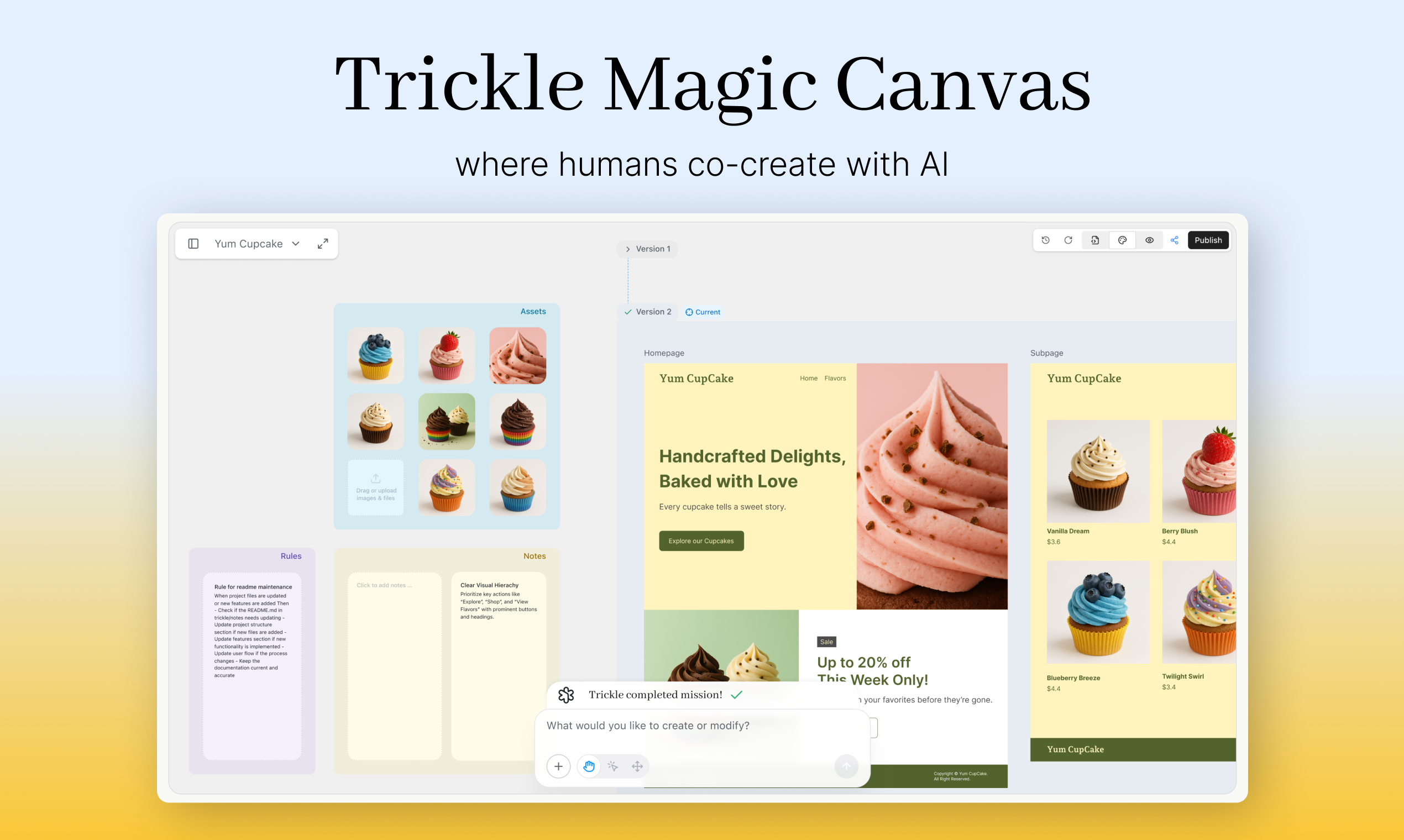- Home
- AI App Builder
- Trickle

Trickle
Open Website-
Tool Introduction:Visual co-build with AI to ship multi-page apps & sites, code in sync.
-
Inclusion Date:Oct 28, 2025
-
Social Media & Email:
Tool Information
What is Trickle AI
Trickle AI’s Magic Canvas is an agentic, visual workspace for co-creating production-ready apps and websites with AI. Unlike traditional flows that split design from coding or depend on long prompt threads, the canvas centers context engineering: you sketch intent, drag components, and refine layouts while an AI agent interprets goals and continuously synchronizes designs with clean code across multi-page structures. This tight design-to-code loop helps teams move from idea to shippable output faster, with greater clarity, fewer handoffs, and a shared source of truth between interface, logic, and final deployment.
Trickle AI Features
- Agentic canvas for context engineering: Provide intent visually; the AI agent infers structure, behavior, and style to accelerate build-out.
- Design-to-code synchronization: Every drag, resize, and tweak is automatically translated into clean, inspectable code.
- Multi-page application scaffolding: Build and connect pages, routes, and shared components without leaving the canvas.
- Intuitive visual editing: Drag-and-drop components, select elements, and adjust properties with immediate feedback.
- Live preview and iteration: See UI and logic updates in real time to shorten feedback loops.
- Collaboration-friendly workflow: Reduce handoffs between designers and developers with a shared, visual source of truth.
- Reusable components: Compose interfaces from modular pieces to maintain consistency and scale designs.
- Code export and handoff: Move from canvas to production with exportable code and alignment to development best practices.
- Human-AI Interaction 3.0: A new interface paradigm for agentic AI and next-generation “vibe coding.”
Who Is Trickle AI For
Trickle AI suits product designers, front-end developers, founders, and agencies who need to ship multi-page applications and websites quickly without losing fidelity between design and code. It also supports cross-functional product teams validating ideas, growth teams launching marketing sites, and educators demonstrating modern visual development and AI-assisted app building.
How to Use Trickle AI
- Open Magic Canvas and describe your goal or paste context (requirements, content, references).
- Let the agent propose an initial layout and app structure based on your intent.
- Drag, select, and adjust components to refine hierarchy, spacing, and styles.
- Add pages, link navigation, and define shared elements to form a multi-page app.
- Configure component properties and simple behaviors directly in the canvas.
- Preview changes live; iterate with brief prompts and visual edits.
- Inspect the synchronized code, run checks, and polish details.
- Export or hand off the production-ready project for deployment.
Trickle AI Industry Use Cases
Startups prototype and ship MVP dashboards with multi-page flows in days, not weeks. Agencies co-create marketing sites alongside clients, aligning on layout and copy while the agent keeps code in sync. Product teams rebuild internal tools—such as admin panels or analytics views—rapidly, using reusable components across pages. Educators and bootcamps teach modern design-to-code practices through a tangible, agentic interface.
Trickle AI Pros and Cons
Pros:
- Bridges design and development with continuous code synchronization.
- Accelerates multi-page app creation through agentic assistance.
- Reduces handoffs and context loss across teams.
- Supports iterative, visual editing with real-time feedback.
- Encourages reusable, consistent components at scale.
Cons:
- Requires a mindset shift to context engineering and agentic workflows.
- Complex edge cases may still need manual code refinement.
- Team adoption and process alignment can take time.
Trickle AI FAQs
-
What makes Magic Canvas different from prompt-only AI tools?
It centers a visual, agentic workflow. You express intent by editing the canvas, and the agent maintains synchronized code, reducing back-and-forth prompts.
-
Can it build multi-page applications?
Yes. You can create multiple pages, link navigation, and reuse components across the app while the agent keeps structure and code aligned.
-
Do I need to be a developer?
No coding is required to start. Designers and product folks can build visually, while developers can inspect and refine the underlying code when needed.
-
How does design-to-code synchronization help teams?
It provides a single source of truth. Visual edits instantly become code, minimizing misinterpretation, rework, and communication overhead.



